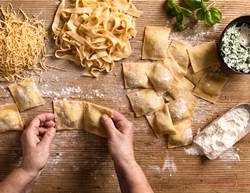Most of us know that upping our daily intake of healthy protein is a nifty hack to build muscle, strengthen the immune system and support cell function. But, the latest thinking is that we need even more protein than many of us are currently eating.
Nutrition scientist Dr Donald Layman, one of the world’s leading protein researchers, suggests we should be aiming for 100g a day to get the full benefits, including weight loss and feeling full.
Why eat more protein?
We start to lose muscle mass every year from about the age of 30, which makes eating more protein (and adding resistance training to your workout!) especially vital for women as they head into midlife, explains dietitian Susie Burrell.
Our busy lives are jam-packed with responsibilities, too, making it all too easy to reach for convenient meal options that tend to be higher in kilojoules and processed carbohydrates – choices “our bodies can’t burn off as efficiently as in our 20s and 30s”, says Susie.
Our protein needs also start to increase about age 40, says nutritionist Dawn Jackson Blatner, because the body’s ability to process it becomes less efficient with age.
Add to this growing evidence that consuming more protein than the recommended dietary intake (about 60–70g) reduces bodyweight and helps to build and maintain muscle tone, and it becomes a good idea to rethink your go-to snacks.
How do I get enough?
It’s easier to hit your 100g protein goal if you distribute your intake throughout the day, rather than squeezing it all onto your dinner plate in the evening. Susie suggests adding more protein to morning meals and snacks and keeping the “fuel a little lower in the second half of the day”, to counteract your lower activity levels and tendency to gain more weight in midlife.
You don’t need fancy products to add to your smoothie, either. You can add protein to smoothies without protein powder. And there are plenty of more natural, less processed ways to meet your protein needs.
Choose healthy, lean meats, fish and chicken and low- or reduced-fat, high-protein dairy options. And don’t forget plant-based proteins: legumes, wholegrains, tofu, nuts and seeds may pack a slightly lower protein punch per gram, but are high in fibre. Fibre is a nutrient that helps you maintain a healthy weight, and one that most of us are lacking, according to research by the Australian Bureau of Statistics.
If you're on a vegan diet, you may want to speak to a dietitian on how to get enough protein.

What high-protein foods should I be eating?
Here’s your guide to getting the recommended 100g of protein every day. Keep this list handy and start building up your protein bank.
| Scotch fillet steak | 150g, grilled | = 35g protein |
| Chicken breast | 100g, grilled | = 31g protein |
| Sashimi | 5 pieces | = 26.5g protein |
| Tuna roll sushi | 8 pieces | = 24g protein |
| Edamame | 1 cup | = 18.4g protein |
| Low-fat milk | 250ml | = 11g protein |
| Poached eggs | 2 medium | = 11g protein |
| Cheddar cheese | 40g | = 10g protein |
| Cottage cheese | ½ cup | = 14g protein |
| Trail mix | Handful (55g) | = 8g protein |
| Tofu | 100g | = 8g protein |
| Legumes | ½ cup, cooked | = 8g protein |
| Chickpeas | ½ cup | = 7.5g protein |
| Yoghurt | 150g | = 7g protein |
| Peanut butter | 2 flat tablespoons | = 7g protein |
| Cooked pasta | 1 cup | = 7g protein |
| Multigrain bread | 2 slices | = 7g protein |
| Cooked brown rice | 1 cup | = 5g protein |
| Cooked white rice | 1 cup | = 3g protein |
| Natural muesli | ¼ cup | = 3g protein |
| Raw almonds |
12 | = 3g protein |










